Table of Contents
- Introduction
- Editor’s Choice
- Electric Powertrains Market Overview
- History of Electric Powertrains
- Largest Regional EV Markets Based on Sales
- Key Manufacturers in the EV Market
- Electric Vehicle Sales
- Number of Electric Vehicles in Use Worldwide
- Electric Train Activity Across Different Countries and Regions
- Investments in Electric Power Trains
Introduction
According to Electric Powertrain Statistics, Electric powertrains, essential to modern electric vehicles, comprise several key components. The battery pack, composed of lithium-ion cells, stores energy, while the electric motor converts this energy into mechanical power for propulsion.
Power electronics manage the flow of electricity between the battery and motor, optimizing efficiency. Some vehicles feature transmissions, though single-speed setups are common due to the motor’s versatility.
Charging systems enable replenishment from external sources, and regenerative braking recaptures energy during deceleration.
Electric powertrains offer advantages such as lower emissions and smoother operation, positioning them as pivotal in the transition to sustainable transportation.
Editor’s Choice
- The global electric powertrain market revenue reached USD 131 billion in 2023.
- By 2032, the electric powertrain market is projected to cross the trillion-dollar threshold, achieving a total of USD 1,015 billion, with BEVs alone accounting for USD 730.8 billion, highlighting a sustained and robust interest in electric powertrain technologies across various vehicle types.
- The distribution of market shares among different electric powertrain types highlights a diverse landscape within the industry. Mild hybrid electric vehicles (MHEVs) hold the largest market share, accounting for 39% of the market.
- In 2021 and 2022, China led the sales of plug-in electric vehicles totaling 3,396,000 units.
- In 2022, global EV sales peaked at 10.2 million units.
- Jaguar Land Rover (JLR) is one of the standout examples in this shift, with a planned investment of £15 billion over five years to transform its operations and vehicle lineup to be predominantly electric by 2030.
- The Biden-Harris Administration earmarked $15.5 billion in 2023 for upgrading existing automotive manufacturing facilities to support electric vehicle (EV) adoption, comprising $2 billion in grants and up to $10 billion in loans.
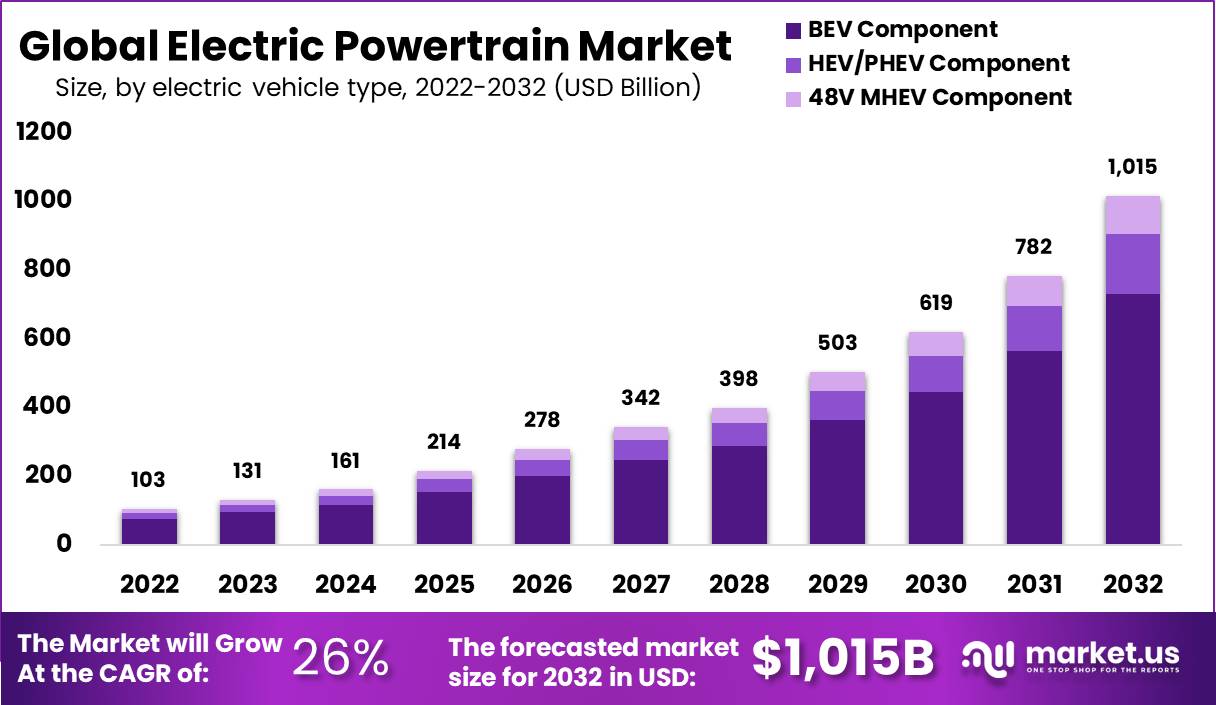
Electric Powertrains Market Overview
Global Electric Powertrains Market Size
- The global electric powertrain market has demonstrated significant growth, with revenue projections escalating impressively over the decade at a CAGR of 26%.
- In 2022, the market was valued at USD 103 billion. By 2023, it rose to USD 131 billion, reflecting a robust growth trajectory.
- This upward trend continued into 2024 when the market revenue reached USD 161 billion. The following year, 2025, saw a further increase to USD 214 billion, underscoring the accelerating adoption of electric powertrains.
- By 2032, the market is anticipated to surpass the trillion-dollar mark, achieving a milestone revenue of USD 1,015 billion.
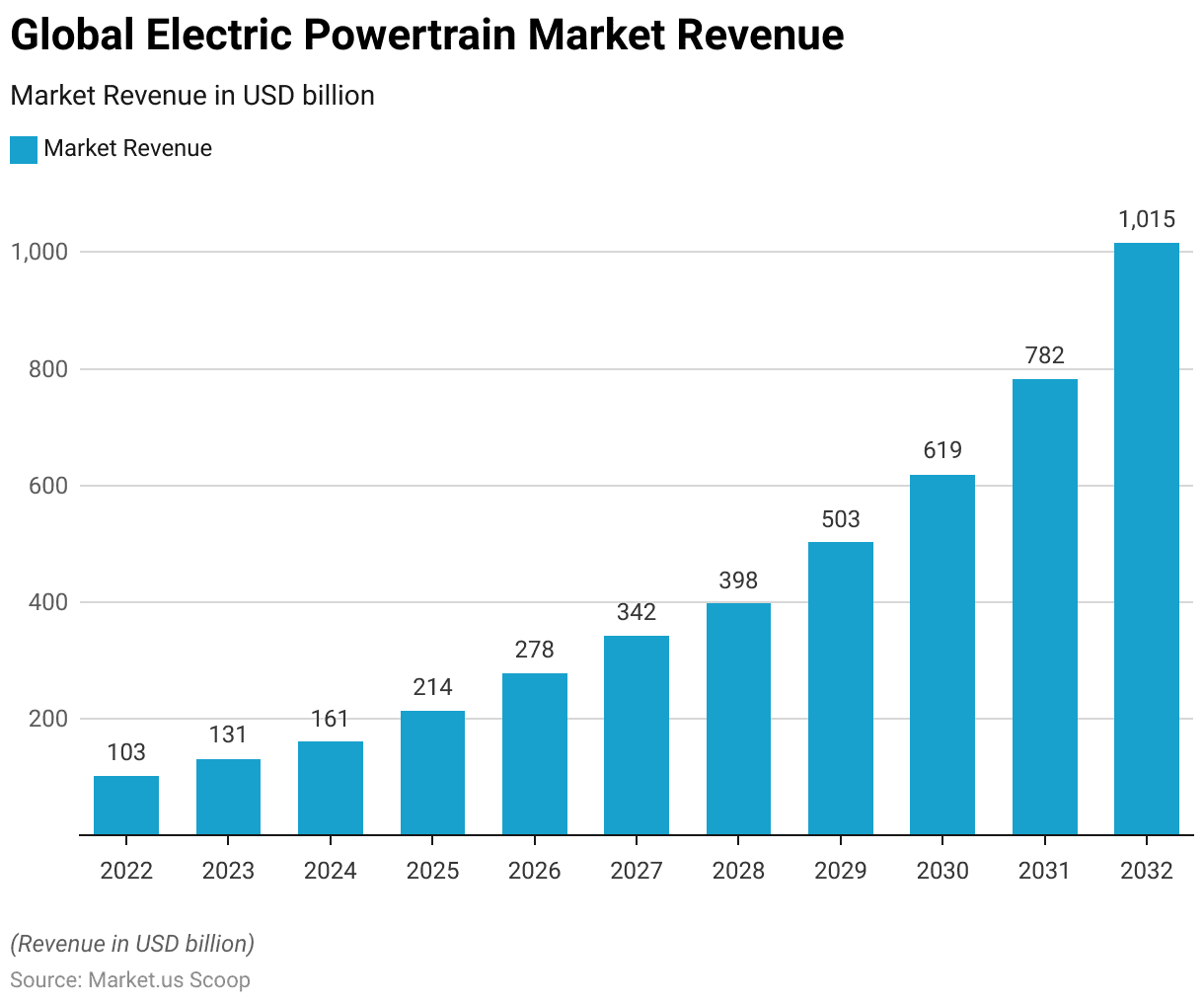
Electric Powertrains Market Size – By Electric Vehicle Type
- The global electric powertrain market has experienced remarkable growth across different vehicle types over recent years.
- In 2022, the market’s value was USD 103 billion, primarily driven by battery electric vehicles (BEVs), which generated USD 74.16 billion.
- Hybrid electric vehicles (HEVs) and plug-in hybrid electric vehicles (PHEVs) also made significant contributions, totaling USD 17.51 billion, with 48V mild hybrid electric vehicles (MHEVs) adding another USD 11.33 billion.
- By 2023, the market had grown to USD 131 billion, fueled by increases across all categories, with BEVs reaching USD 94.32 billion, HEV/PHEVs at USD 22.27 billion, and 48V MHEVs at USD 14.41 billion.
- By 2032, the electric powertrain market had crossed the trillion-dollar threshold, achieving a total of USD 1,015 billion, with BEVs alone accounting for USD 730.8 billion, highlighting a sustained and robust interest in electric powertrain technologies across various vehicle types.

Global Electric Powertrains Market Share – By Powertrain Type
- The distribution of market shares among different electric powertrain types highlights a diverse landscape within the industry.
- Mild hybrid electric vehicles (MHEVs) hold the largest market share, accounting for 39% of the market.
- Battery electric vehicles (BEVs) also command a significant portion, representing 27% of the market.
- Series hybrid powertrains follow with an 18% share, underscoring their relevance in the current market.
- Parallel hybrid powertrains capture 11%, while series-parallel hybrid powertrains, combining features of both series and parallel systems, have the smallest share at 5%.
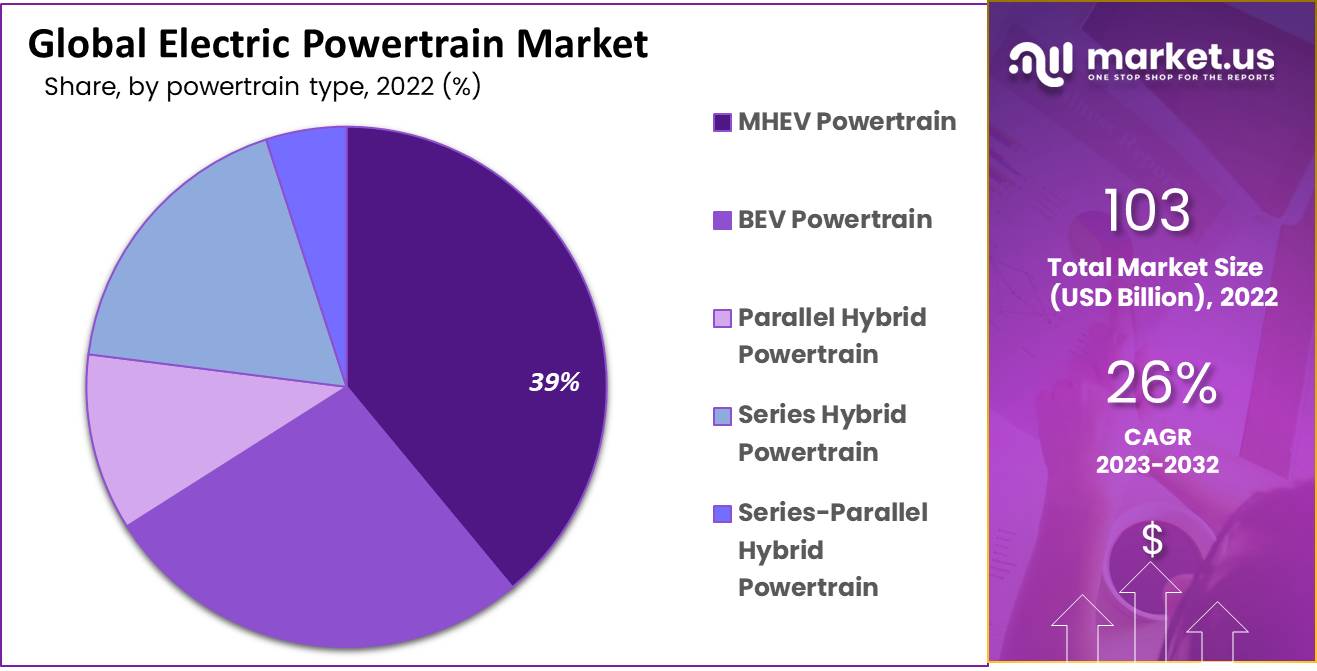
History of Electric Powertrains
- The history of electric powertrains reflects a journey of innovation and technological adaptation over the decades.
- Starting around the early 20th century, electric motors were as common as internal combustion engines, particularly in urban settings, due to their smooth operation.
- Significant advancements occurred in the 1960s, with Bosch exploring electric alternatives for lower emissions.
- By the 1970s, experiments with electric buses and hybrid technologies that combined internal combustion engines with electric motors set the stage for future developments.
- This led to the first production of cars with Bosch hybrid technology in 2010 and further innovations in battery electric vehicles, integrating high-efficiency components like Silicon carbide semiconductors.
Largest Regional EV Markets Based on Sales
- In 2021 and 2022, the sales of plug-in electric vehicles exhibited significant growth in major markets around the world.
- In 2021, China led the charge with substantial sales totaling 3,396,000 units. This figure soared to 6,181,000 units in 2022, demonstrating a remarkable increase in demand within the region.
- Europe (West and Central) also showed a strong performance, with sales rising from 2,332,000 units in 2021 to 2,683,000 units in 2022.
- North America experienced a notable uplift in sales from 748,000 units in 2021 to 1,108,000 units in 2022, reflecting growing market acceptance.
- The ‘Other’ category, representing smaller markets collectively, nearly doubled its sales from 291,000 units in 2021 to 551,000 units in 2022.

Key Manufacturers in the EV Market
- In 2023, the global plug-in electric vehicle market was characterized by a varied distribution of market shares among leading manufacturers.
- BYD emerged as the frontrunner, capturing a substantial 22% of the market, indicating a strong presence in the electric vehicle industry.
- Tesla Inc. followed with a 13.2% market share, maintaining its significant role in the sector.
- VW Group held a 7.3% share, reflecting its steady participation in the electric vehicle market.
- Geely-Volvo Car Group closely trailed with a 6.8% share, while SAIC accounted for 5.8% of the market.
- The remainder of the market, amounting to 45%, was held by a diverse array of other manufacturers, illustrating a competitive and fragmented market landscape where numerous players contribute to the broader push toward electric mobility.
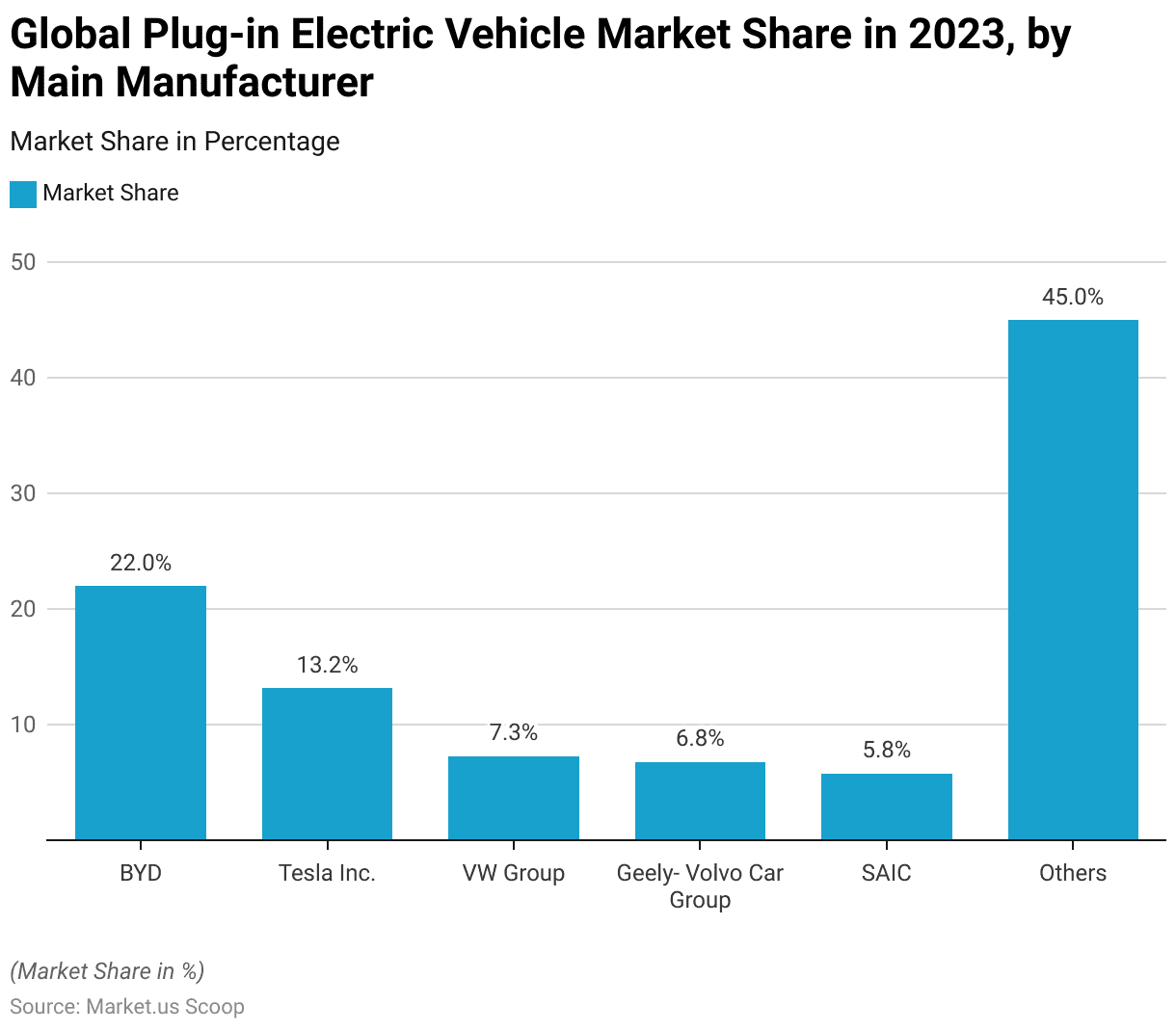
Electric Vehicle Sales
- The global sales of plug-in electric light vehicles have shown a significant upward trend from 2015 to 2022.
- Starting in 2015, the sales were modest, with approximately 0.55 million units sold. The following year, 2016, saw a slight increase to 0.75 million units.
- The growth continued more notably in 2017, with sales reaching 1.18 million units.
- This rapid growth persisted into 2022, when sales peaked at 10.2 million units, reflecting a robust and accelerating adoption of plug-in electric vehicles worldwide.
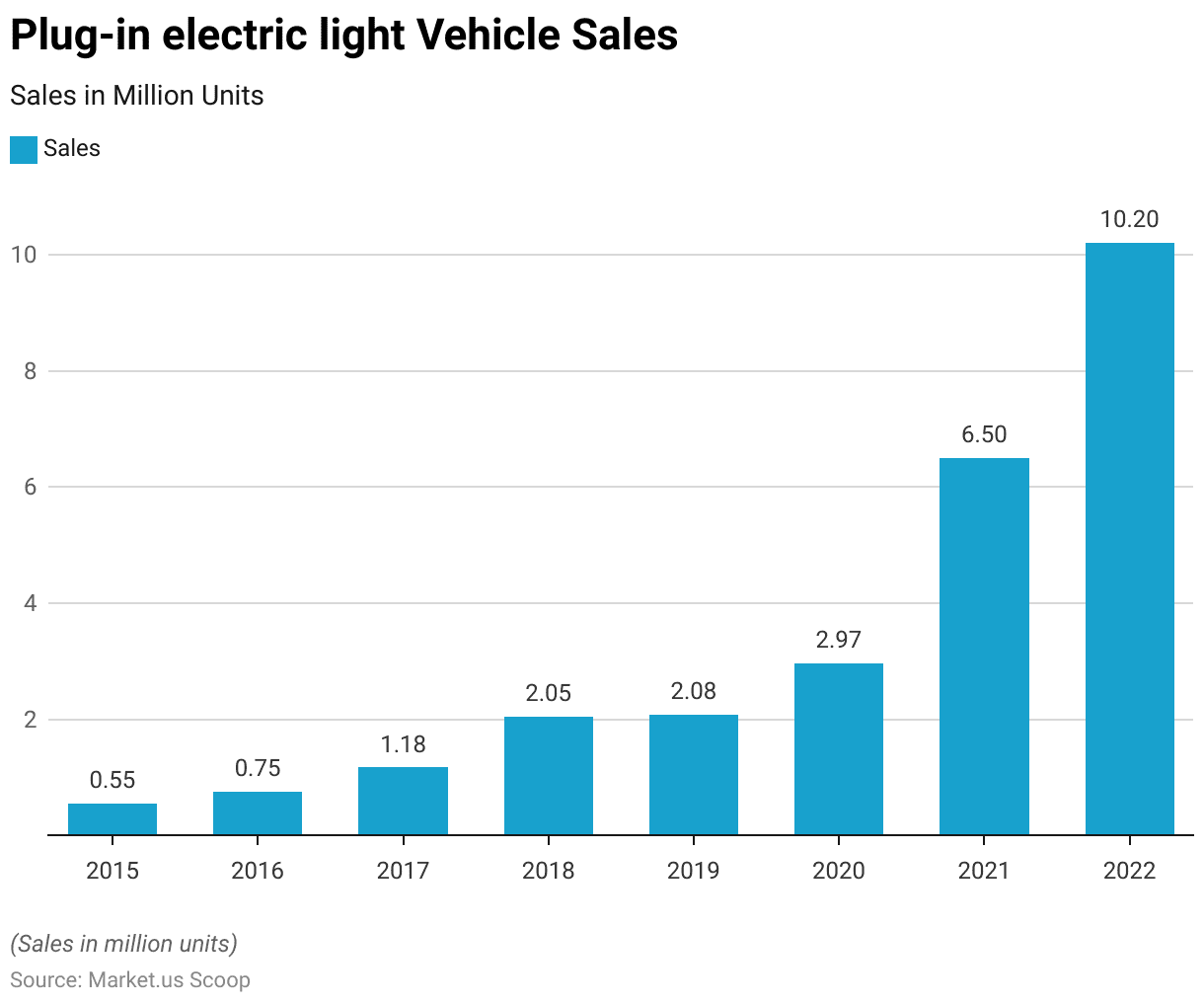
Number of Electric Vehicles in Use Worldwide
- Between 2016 and 2022, the global population of electric vehicles (EVs) experienced robust growth, distinguished by type into plug-in electric and battery electric vehicles.
- In 2016, the number of plug-in electric vehicles in use was approximately 808,180 units, while battery-electric vehicles numbered around 1,191,420 units.
- The following year, 2017, saw these figures rise to 1,205,610 for plug-in electrics and 1,937,270 for battery electrics.
- By 2018, the counts escalated further to 1,834,970 plug-in electric and 3,264,800 battery-electric vehicles.
- In 2022, the expansion persisted, with plug-in electric vehicles estimated at 7.9 million and battery electric vehicles at an impressive 18 million, highlighting a continuing trend toward electric vehicle adoption globally.

Electric Train Activity Across Different Countries and Regions
- The utilization of electric trains across various countries and regions has shown diverse trends from 2000 to 2015.
- In 2000, North America had 73% of its trains electrified, while Europe had a slightly higher percentage at 76%. Japan led with a high rate of 97% electrification, contrasted with Korea and China with 53% and 31%, respectively. Russia’s electrification stood at 81%, India at 44%, South America at 41%, and Africa at the lowest with 21%.
- By 2005, there was a slight increase across most regions; North America rose to 75%, Europe to 79%, and Korea saw a significant jump to 72%. China and India’s figures also grew modestly to 43% and 46%, respectively.
- By 2015, North America and Europe both reached an 80% electrification rate. Japan continued to lead with 97%, while Korea approached near-total electrification at 90%. Russia, China, and India also made progress, with rates of 86%, 75%, and 54%, respectively. South America and Africa continued to see modest increases, reaching 49% and 28% electrification.
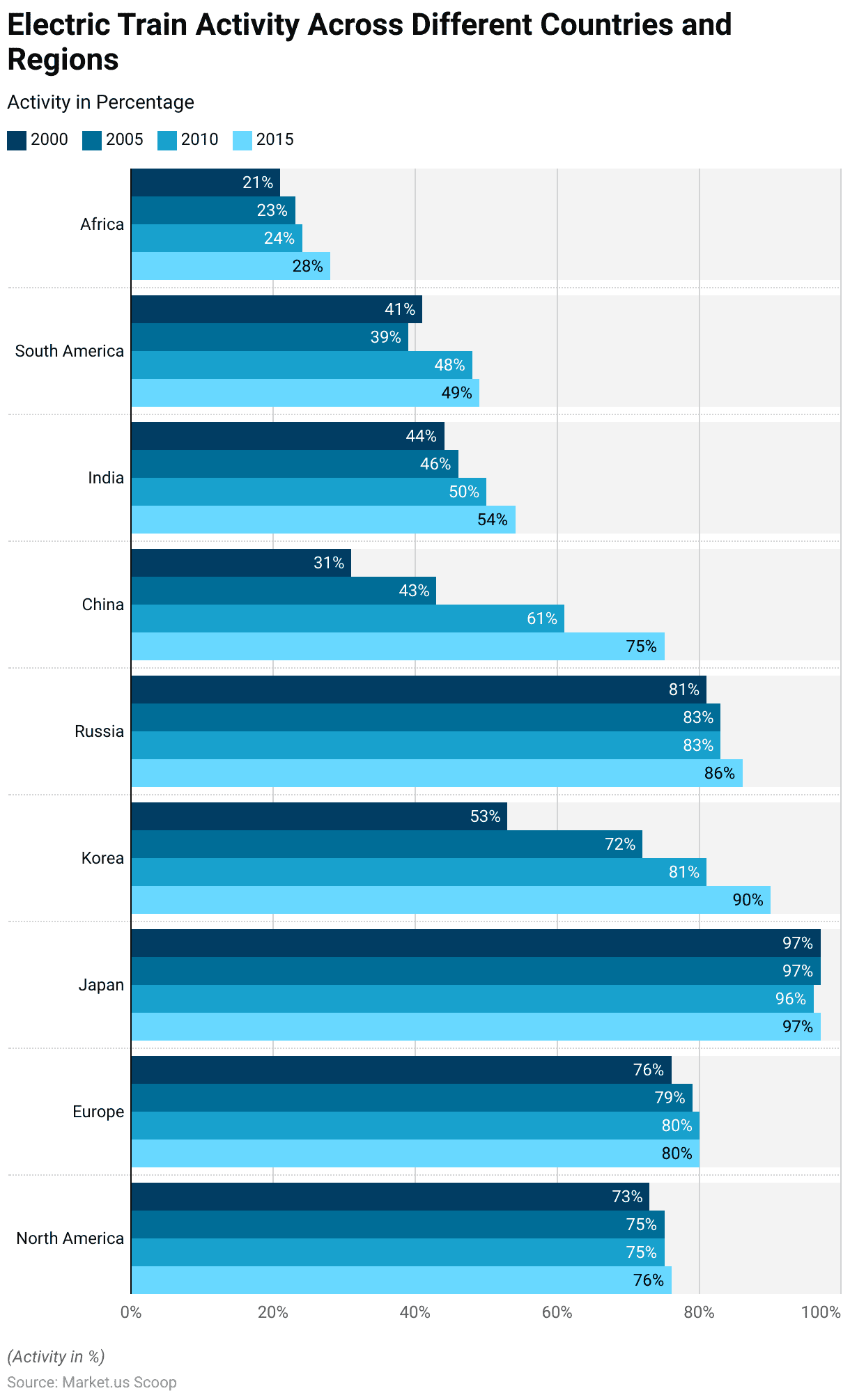
Investments in Electric Power Trains
Private Sector Investments
- Investments in electric powertrains are surging as automotive companies and suppliers shift their focus toward electric vehicles (EVs). Significant capital is being funneled into the development and production of electric powertrain components, a trend underlined by ambitious investment announcements from major automotive manufacturers.
- For example, automotive OEMs have disclosed investments exceeding $500 billion for general electrification efforts aimed at completion by 2025, although actual figures could be much higher.
- These investments are not only for developing electric vehicles but also for creating in-house capabilities for critical components such as e-drive units and battery packs. However, some elements, like battery cells, may still be outsourced.
- Jaguar Land Rover (JLR) is one of the standout examples in this shift, with a planned investment of £15 billion over five years to transform its operations and vehicle lineup to be predominantly electric by 2030.
Government Investments
- In 2023, the U.S. government significantly bolstered electric powertrain technologies, demonstrating a strong commitment to advancing transportation electrification and bolstering energy security.
- The Biden-Harris Administration earmarked $15.5 billion for upgrading existing automotive manufacturing facilities to support electric vehicle (EV) adoption, comprising $2 billion in grants and up to $10 billion in loans.
- Additionally, a $13 billion investment was designated to modernize and expand the national power grid, promoting the integration of renewable energy sources and enhancing resilience against severe weather.
- The Indian government is actively boosting the electric vehicle (EV) sector to promote sustainable transportation and reduce reliance on fossil fuels.
- The second phase of the Faster Adoption and Manufacturing of Hybrid and Electric Vehicles (FAME II) scheme aims to drive EV adoption across various vehicle categories. Anticipated investments of $20 billion by 2030 prioritize advanced battery production and local EV component manufacturing, supported by production-linked incentives and government funding.
Discuss your needs with our analyst
Please share your requirements with more details so our analyst can check if they can solve your problem(s)



